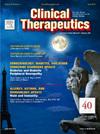直接口服抗凝剂治疗房颤伴肾小球高滤过患者的疗效和安全性:一项系统综述和荟萃分析
IF 3.6
4区 医学
Q2 PHARMACOLOGY & PHARMACY
引用次数: 0
摘要
目的:本研究的目的是确定直接口服抗凝剂(DOACs)与华法林在肾功能异常患者中的治疗效果。方法:系统检索PubMed和Embase至2022年9月25日。符合预先指定的选择标准的文章被纳入。如果不存在显著异质性,则选择固定效应模型。进行亚组分析以找出异质性的来源。可能扩大异质性的变量选择如下:(1)DOAC类型,(2)DOAC剂量,(3)肾小球滤过率估算方程,(4)原始研究类型。结果:共纳入7项研究,涉及87,514例患者。在肌酐清除率(CrCl)为80 mL/min的患者中,与华法林相比,DOACs与总体疗效结果的显著降低相关(风险比[HR] = 0.75;95% ci, 0.66-0.86;P < 0.0001;I2 = 66%),但卒中/系统性栓塞不存在(HR = 0.90;95% ci, 0.72-1.14;P = 0.40;I2 = 17%)。同样,与华法林相比,DOACs显示出更低的安全结局风险(HR = 0.68;95% ci, 0.63-0.74;P < 0.0001;I2 = 45%)。在CrCl浓度为95 mL/min的患者中,DOACs与有效性结局的临界低风险相关(HR = 0.83;95% ci, 0.68-1.01;P = 0.07;I2 = 61%),安全结局风险显著降低(HR = 0.66;95% ci, 0.58-0.76;P < 0.0001;I2 = 0%),尤其是大出血(HR = 0.63;95% ci, 0.53-0.76;P < 0.0001;I2 = 0%)和颅内出血(HR = 0.43;95% ci, 0.30-0.62;P < 0.0001;I2 = 0%)。意义:在心房颤动和CrCl bb0 80 mL/min的患者中,doac比华法林有更大的临床益处。对于房颤和CrCl浓度为95 mL/min的患者,DOACs的安全性结果明显更好。本文章由计算机程序翻译,如有差异,请以英文原文为准。
Efficacy and Safety of Direct Oral Anticoagulants for Patients With Atrial Fibrillation With Glomerular Hyperfiltration: A Systematic Review and Meta-Analysis
Purpose
The purpose of this study was to identify possible therapeutic benefits of direct oral anticoagulants (DOACs) compared with warfarin in subjects with supranormal renal function.
Methods
PubMed and Embase were systematically searched until September 25, 2022. Articles that met the prespecified selection criteria were included. The fixed-effects model was chosen if there is no significant heterogeneity. Subgroup analyses were conducted to find the sources of heterogeneity. Variables that might expand heterogeneity were selected as follows: (1) type of DOAC, (2) dose of DOAC, (3) equation for glomerular filtration rate estimation, and (4) types of original research.
Findings
A total of 7 studies involving 87,514 patients were included. In patients with creatinine clearance (CrCl) >80 mL/min, DOACs were associated with a significant reduction in the overall effectiveness outcomes compared with warfarin (hazard ratio [HR] = 0.75; 95% CI, 0.66–0.86; P < 0.0001; I2 = 66%), but not for stroke/systematic embolism (HR = 0.90; 95% CI, 0.72–1.14; P = 0.40; I2 = 17%). Similarly, DOACs showed a decreased risk of safety outcomes compared with warfarin (HR = 0.68; 95% CI, 0.63–0.74; P < 0.0001; I2 = 45%). In patients with CrCl >95 mL/min, DOACs were associated with a borderline lower risk of effectiveness outcomes (HR = 0.83; 95% CI, 0.68–1.01; P = 0.07; I2 = 61%) and significantly lower risk of safety outcomes (HR = 0.66; 95% CI, 0.58–0.76; P < 0.0001; I2 = 0%), particularly major bleeding (HR = 0.63; 95% CI, 0.53–0.76; P < 0.0001; I2 = 0%) and intracranial hemorrhage (HR = 0.43; 95% CI, 0.30–0.62; P < 0.0001; I2 = 0%).
Implications
In patients with atrial fibrillation and CrCl >80 mL/min, DOACs have greater clinical benefits than warfarin. For those with atrial fibrillation and CrCl >95 mL/min, significantly better safety outcomes were observed for DOACs.
求助全文
通过发布文献求助,成功后即可免费获取论文全文。
去求助
来源期刊

Clinical therapeutics
医学-药学
CiteScore
6.00
自引率
3.10%
发文量
154
审稿时长
9 weeks
期刊介绍:
Clinical Therapeutics provides peer-reviewed, rapid publication of recent developments in drug and other therapies as well as in diagnostics, pharmacoeconomics, health policy, treatment outcomes, and innovations in drug and biologics research. In addition Clinical Therapeutics features updates on specific topics collated by expert Topic Editors. Clinical Therapeutics is read by a large international audience of scientists and clinicians in a variety of research, academic, and clinical practice settings. Articles are indexed by all major biomedical abstracting databases.
 求助内容:
求助内容: 应助结果提醒方式:
应助结果提醒方式:


